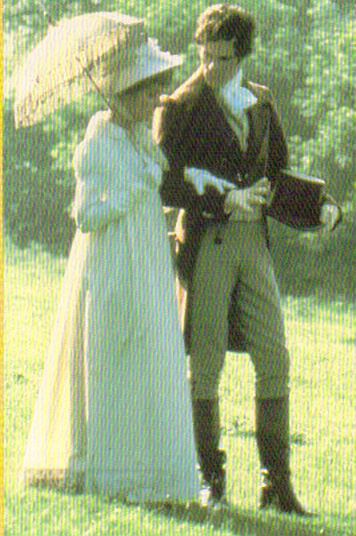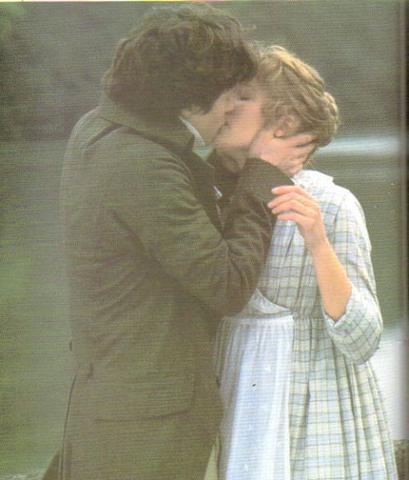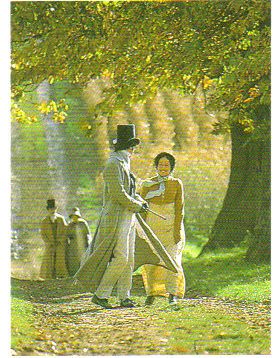Ellen and Jim Have a Blog, Too
We are two part-time academics. Ellen teaches in the English department and Jim in the IT program at George Mason University.


After the Proposal: Similarities & cut scenes in the Austen films · 13 January 07
Dear Judy,
Thank you for your comments on my comparison of the two films. Yes I see I misunderstood. I was thinking of the only DVD of the movie I own: the one Laura bought me for Xmas. As far as I can tell none of the old movies put on DVD have any of these features or extras. I’ve not opened the packaging as I’ve started watching the Pallisers and also all but one time I’ve played DVD on my computer the computer crashes and I haven’t figured out to prevent this and it frustrates and even frightens me. I have to unplug the computer in order to get it going again!
Yes the "extra" or bonus commentary in the 1995 DVD of S&S is a voice-over and you have to watch the movie as you listen to it. It distances you from the movie and goes ever so slow. I found it tiresome. As I recall there was little actual information offered.
Let me say this about these featurettes where the director or someone on the crew tells you about the making of the film. According to the man who gave one of the papers at the MLA on "bogus and bonus" features, a lot of the talk is simply not true. He had information on two of the commentaries he brought. Mostly they leave out all the politics (personal, political, about money) which are important. Sometime they go further than that and exaggerate what they did or didn’t do. It’s rationalization after the fact. He also said (this I’ve heard before) that oftentimes the functions give people on the credits are not actually what they did. A man may be far more involved in directing and yet called a producer; he may make more important decisions on how something is done than the director as he’s gotten the money-package together. Now I’ve watched some of the "featurette" on how The Lord of the Rings was made and they seemed truthful in some ways. They have to tell you something, and they give away things. I think you learn a lot about the costumes and the place the people filmed. As you know though, there’s also a lot of misleading happy banter.
Just a word of scepticism I can’t resist.
On the "extras" for the DVD of the 1995 S&S: I think there are 2 or 3 scenes added. I can only remember one. Isabel rented the DVD; we don’t own it so we watched it only twice; she watched the film through twice; I did come back to see the left out scene more than once. Why? It’s the one where Edward (Grant) kisses Elinor (Thompson) and it’s so sweet. If you’ve not seen it, here it is:
The scene corresponds closely to the one between Darcy (Firth) and Elizabeth (Ehle) in the 1995 P&P: both scenes from these movies are taken from the penultimate chapter of the two novels; in both cases the screenplay writer has eliminated the overt didacticism. Austen’s Darcy says he learned X from all that has happened, and now sees how bad was his education for him; Austen’s Edward says he learned X from all that has happened with Lucy, and now sees he should have been given some useful employment. Thompson and Davies turned their talk into reminiscing, a sort of nostalgia moment inside happiness. Thompson was more daring: she had her couple kiss; Davies (apparently) did not:
The above joyous pastoral scene (just look at the flowering trees, the gold and green and yellow) does not appear in the present 1995 P&P; it comes from the Birtwistle book The Making of Pride and Prejudice. I don’t know if it’s included in the "extra" scenes in the latest DVDs. I love her laughing and him relaxed at last.
In the screenplay diaries by Emma Thompson where you get the kind of extra featurette you’re wanting in the back of the book—decisions are presented and descriptions of filming. There too there is happy banter and telling the less acceptable reasons for some of the things decided or are omitted. Thompson says this walking over the bridge and kissing scene was omitted because it was thought the ecstacy of the child in the treehouse was more effective. (Perhaps you could see if you could get this book from a library or buy it; in the US it’s available in paperback. The screenplay is of real literary quality; it includes the scene where Brandon [Rickman] visits Eliza Williams in the spongehouse as flashback.) You can only get some of these cut-scenes of kisses on the cover illustrations of the VHS cassettes—unless you buy the "making" books. I recommend the screenplay and diaries of S&S not for the discussion afterwards so much (though it’s revealing a bit) but rather for the screenplay itself.
I suggest from the adverse commentary the first kiss of an Austen couple got just from a false cover (in Persuasion 1995), very narrow-minded, resentful almost, they also feared to present this beautiful tender half-eager, half-fearful reluctant kiss.
Having watched all but the 1971 Persuasion, I’d like to report that a motif in just about all (not all quite) of these Austen adaptations is to show the loving couple walking deep into a meadow during the proposal scene. In the 1972 Emma they go into a gazebo and it’s a rare scene shot on some location. But in the 1972 Emma, the 1979 P&P, and the 1995 P&P, there’s no kiss. The 1979 is tasteful and is shown on some of the older covers of the VHS video cassettes. Like the analogous scene in the 1972 Emma it’s an uncommon moment shot on location:

The first kiss then may have occurred in the original filming of the 1996 S&S but it was cut; I suggest the cover illustration of the Persuasion where Wentworth (Hinds) kisses Anne (Root) comes from a similarly cut scene. You see we are not told this sort of thing in the featurettes (!—hmmmn). In the 1983 MP there’s a scene of Edmund (Farrell) and Fanny (Le Tousel) walking after they marry, but she’s carrying a pug. It’s witty (as she is now in Lady Bertram’s role we see). The 1996 MP by Rozema shows a deeply sensual physical kissing; there’s the first that was shown. Remember the vitriolic attacks that film got. And the 2005 P&P had them kissing intensely and then afterwards in the park they sat on a stone platform (round) and she was all bliss because now she was Mrs Darcy. They kissed again. Tellingly, this got no commentary here in the US until we were told that this final scene was originally not shown in the UK. Janeite types who distrust any sex appearing in the films have now grown used to it.
For my part I miss the kiss in the earlier versions.
In several of Edith Wharton’s novels she seems to me to rewrite or replay motifs in Austen’s novels, only turning them dark and pessimistic from a different interpretion. Summer rewrites S&S in part; Lily in The House of Mirth can be seen as a Mary Crawford figure, with the plainer hero and heroine who survive, he abandoning the heroine from moral disdain he’s got no right to have, and she at long last also not helping the heroine in the end would be the Fanny and Edmund figures. I can’t remember any more but recall enough to say one story or novel by Wharton also seemed to me to replay the Emma story but again more darkly.
I’ll try to remember over the course of today.
Hugs,
Ellen
--
Posted by: Ellen
* * *
Comment
- P.S. Since writing this blog, I watched the featurettes of the 1995 DVD A&E/BBC P&P.
The featurettes are weak: they tell you a lot less than the book, The Making of Pride and Prejudice by Sue Birtwistle. The featurettes include a lot of selling the movie itself; incessant remarks on how popular and different it was from all others that had gone before. A lot of happy banter—Adrian Lukis reads the script. You can pick up some things: for example, the desire to be popular; the desire to make the movie active. The most revealing moment was when Birtwistle suddenly justified her having filmed the dancing at Ealing Studios. For a moment she seemed to forget she was talking to a film-going audience, not her peers who make films. She got defensive about using this non-location infra dig older place. She said "it’s made just for these sorts of large dancing sequences. It’s ridiculous [or some such word] not to use it." I began to wonder if the 1996 BBC Emma filmed their dancing sequence at the end at Ealing.
Generally, much more is in The Making of P&P, the book. Birtwistle gives you all the sites the movie was at. The strength of the book Making of P&P is on costume. You learn a lot about costume. They also discuss the use of voice over and the letters; how the content of Darcy’s to Elizabeth’s is reversed; why they divided the voice-over and so on. It’s fun to see the actors and places on live film, but you don’t learn as much as from several pages of pictures.
I could not find any omitted stills in the featurettes. I know they exist only from the book, The Making because I found stills not in the movie (like the one of Darcy and Elizabeth laughing and joyous).
Actually a third book I want to tell of: The Making of Emma. This one contains Andrew Davies’s screenplay as well as pictures of the sites used. There is much less on costume and more by Davies on his reading of the novel. Sombre. The Making of P&P excludes the screenplay.
Some movies have better featurettes. Cynic that I am I think that’s when they are less popular films and so no "secrets" that count are given away. Clarissa was not a pop film. But on the other hand huge cult films have enough featurettes for 3 films. That’s the case with the DVD set of The Lord of the Rings Isabel has.
E.M.
— Ellen Jan 15, 12:17am #
commenting closed for this article


